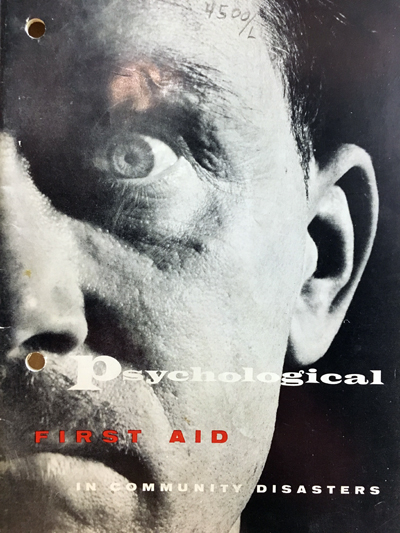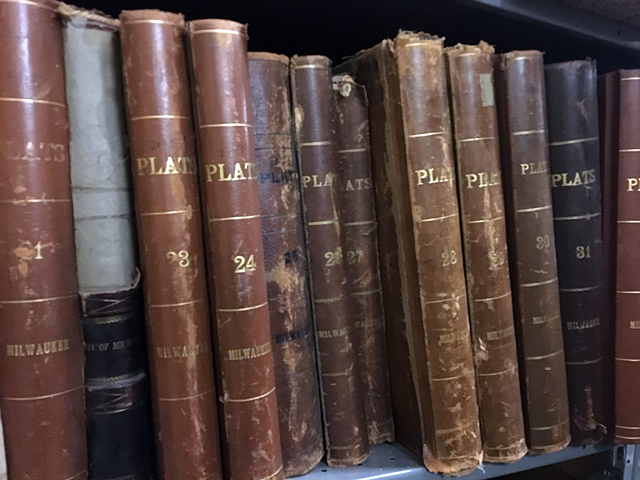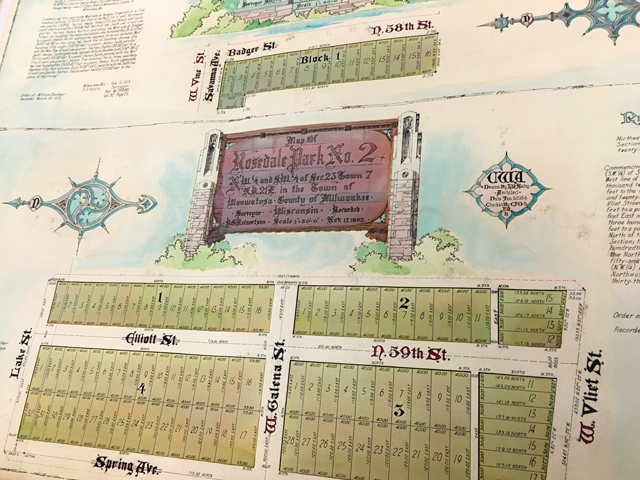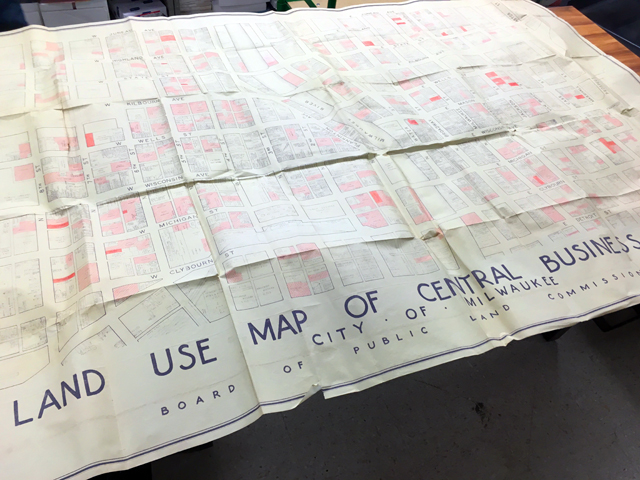The history of Milwaukee lies below ground. About three stories below ground to be exact.
That’s where you’ll find Office of the Common Council/City Clerk – City Records Center, headed by Jacquelyn Block, who has been in the department, amid the stacks of boxes, the rolls of blueprints, the shelves of plat map books in which the quotidian history of the city is inscribed, since 1993.
The department, as you can imagine, is a space-intensive one, occupying a former printing office, as well as a number of storage spaces in the Frank P. Zeidler Municipal Building, 841 N. Broadway, the Department of City Development building next door at 809 N. Broadway, and even some off-site storage, including at the Central Library.

These days, very few of the record types are open to the public. The main ones available for scrutiny are residential building plans dating back to the late 1970s. In the past, the public could see blueprints for public buildings, too. But that all changed on Sept. 11, 2001.
"Up through 9/11, we had quite a flow of members of the public coming in for plans," says Block from her office adjacent to the city’s mail room. "Until that day, you could come in and ask for any type of government building plan: banks, jails – you name it – the airport.

" On 9/10, someone came for a copy of the data communication building the police department has on Lisbon. They didn't get it only because it was after 4:30 (p.m., closing time). Turned out the next day, as the planes were hitting and what not, that it was a disgruntled architect in the city who wanted those plans. That was pretty scary. At the time, all of my superiors were out of town. I said, ‘We're shutting the doors. I don't know what's happening’."

Soon after, the Common Council passed an ordinance classifying what are deemed "secure structures." If someone wants to view plans for those, permission from the building owner (i.e. Milwaukee Police Dept., Milwaukee Public Schools, etc.) is required.
"Before 9/11, we would get about 10,000 requests a year," Block says. "A lot of local business developers, architects, students from various universities studying architecture or history. That type of thing. We get 3,000 or less at this point."
Many of the records held by the department are extremely sensitive and when Block gave me a tour, there were areas we didn’t go, boxes we couldn’t open.
"We have things from every city department; primarily their records, which are on legal retention schedules." Block says. "Police records, city attorney litigation records."
There is stuff everywhere. In the former print shop, there are palettes stacked full of document boxes and rolls and rolls of blueprints, maps and plans. Some boxes have photographs that would make history buffs salivate. Others have remnants of the Cold War: Geiger counters, radiation measurement log books, manuals.
So, how do they decide what to keep?
"Historical value and the law," says Block. "We'd look at administrative value, historic value, legal value and fiscal value. Administratively, will that department need to refer back to that record for whatever reason? In the case of property records, which are primarily permanent records, those are there to provide evidence that a citizen or the government has certain rights and privileges to a property.
"By state law, every record that a government entity creates, it must have a ‘schedule.’ It must be identified with a number, a description, what is the medium, how long are you going to keep it, where are you going to keep it, what's the purpose of that, who is the legal custodian? We have some things from the 1800s."

Some of the most beautiful things in the collection are books of plat maps showing property lines for every lot in the entire city. Some of the books are workaday maps that are interesting from a historical perspective. But others, especially some plats created for new city subdivisions in the 1930s are astonishingly beautiful, having been drawn and inked by architects and artists during Works Progress Administration era.
In some of them, the decoration is so elaborate that the plats of the streets seem almost an afterthought. These are the kinds of records that I can’t help but hope the city digitizes and offers to the public via its website and perhaps even offers quality prints available for purchase.

Wandering around, there’s a wealth of amazing things to behold. We pass a shelf with some maps waiting to be filed and there are surveys of parking trends in Downtown Milwaukee from decades ago. There’s a detailed map of the Downtown business district from the 1940s showing every building on every street and noting how many floors it has and what types of businesses it houses.

There’s also a 1904 map of what was Wauwatosa but has since been annexed by Milwaukee. Every house is marked with a dot in what was then mostly countryside.
Block grabs a box at random off a stack, ensures it’s not sensitive material and pops off the lid. Inside are aerial views of all parts of the city from the 1940s. Another one has records from the Board of Public Land Commissioners. The first page marks the 1915 organization of the committee. Yet another has photographs and newspaper clippings of unbuilt Downtown developments.

Block says even more than 20 years into it, she loves her work.
"It's interesting," she says. "I'll get down into basements and closets and attics and back rooms and all sorts of places and find some amazing things."
Born in Brooklyn, N.Y., where he lived until he was 17, Bobby received his BA-Mass Communications from UWM in 1989 and has lived in Walker's Point, Bay View, Enderis Park, South Milwaukee and on the East Side.
He has published three non-fiction books in Italy – including one about an event in Milwaukee history, which was published in the U.S. in autumn 2010. Four more books, all about Milwaukee, have been published by The History Press.
With his most recent band, The Yell Leaders, Bobby released four LPs and had a songs featured in episodes of TV's "Party of Five" and "Dawson's Creek," and films in Japan, South America and the U.S. The Yell Leaders were named the best unsigned band in their region by VH-1 as part of its Rock Across America 1998 Tour. Most recently, the band contributed tracks to a UK vinyl/CD tribute to the Redskins and collaborated on a track with Italian novelist Enrico Remmert.
He's produced three installments of the "OMCD" series of local music compilations for OnMilwaukee.com and in 2007 produced a CD of Italian music and poetry.
In 2005, he was awarded the City of Asti's (Italy) Journalism Prize for his work focusing on that area. He has also won awards from the Milwaukee Press Club.
He has be heard on 88Nine Radio Milwaukee talking about his "Urban Spelunking" series of stories, in that station's most popular podcast.







